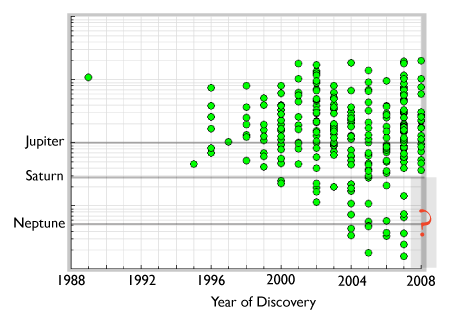
On December 29th 1959 at the annual meeting of the American Physical Society at Caltech, Richard Feynman gave a remarkable talk entitled “There’s plenty of room at the bottom” in which he foresaw the impact that nanotechnology could have on materials science. At the beginning of the lecture he remarked (in a vernacular that dates him to the Eisenhower era):
I imagine experimental physicists must often look with envy at men like Kamerlingh Onnes, who discovered a field like low temperature, which seems to be bottomless and in which one can go down and down. Such a man is then a leader and has some temporary monopoly in a scientific adventure.
Over the past several years, the oklo.org party line has been that the radial velocity method for exoplanet detection is similarly equipped with the potential to go down and down in planet mass, and to continue with at least a respectable share of the lead in the ongoing scientific adventure.
That said, the Doppler returns so far this year have been underwhelming. If we look at the latest planet-mass vs year of discovery diagram on exoplanet.eu (no pulsar planets, no microlenses), the detection rate seems to be holding up, but the crop of announced low-mass planets is nonexistent. Of the 22 new planets so far in ’08 that have been detected via radial velocity, 16 were initially detected by the transit surveys.

What’s up with that?
We’re seeing core accretion in action. The baseline prediction of the core accretion theory for giant planet formation is that once a planet reaches a crossover threshold, where the mass of gas and solids is equal, then rapid gas accretion ensues, and the planet grows very rapidly to Jovian size or even larger. When the galactic planetary census is complete, one thus expects a relative dearth of planets with masses in the range between ~20 and ~100 Earth masses. In the freewheelingly unrefereed forum of a blog post, I can go ahead and dispense with an analysis that takes all the thorny completion issues and selection biases into account and state unequivocally that:

(Courtesy as usual of the exoplanet.eu statistics plot generators)
Planets that do make the grade and blow up to truly Jovian size are the beneficiaries of protostellar disks that had solid surface densities that were well above the average. At a given disk mass, a disk with a higher metallicity has a higher surface density of solids, which is the reason for the planet-metallicity correlation. Disks with higher oxygen and silicon fractions relative to iron will also have high solid surface densities, which is the reason for the planet-silicon correlation. And M stars have trouble putting their Jovian cores together fast enough to get the gas while it’s still there, which is the source of the planet-stellar mass correlation.
As one pushes below Neptune-mass, these correlations should all get much weaker, and the fraction of producing stars should go way up. It’s hard, at the ~10% success rate level for a protostellar disk, to make a Jupiter, and it should be straightforward, at (I’ll guess) the 50% success level for a protostellar disk to make a Neptune.
The gap between Neptune and Saturn is the source of the current RV planet drought. At given velocity precision (in the absence of stellar jitter), it takes ~25x more velocities to detect a Neptune than to detect a Saturn. To make progress, it’s necessary to stop down the number of stars in the survey and focus on as many old, quiet K-type stars as possible. We’re talking HD 69830.
The indications at Harvard were that the Geneva group has been doing just that. In a few hours, Michel Mayor is scheduled to give the lead-off talk at the Nantes meeting on extrasolar super Earths. I’ll post a rundown of what he has to say just as soon as the Oklo foreign correspondents file their reports…

It will be interesting to see how the mass-distribution chart will look a few years from now as the sensitivity/ detection threshold improves. With a greater number of exo-objects it will improve the picture and the mass-range at the bottom will open-up. Indeed, there’s plenty of room at the bottom!
p.s. please could the scale be ‘added’ to the x-axis for clarity?
Pingback: Blog de Astronomia do astroPT » Apontamentos…
Pingback: Blog de Astronomia do astroPT » HAT-P-12b: Um planeta no deserto
Pingback: Blog de Astronomia do astroPT » Vários Planetas